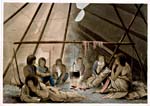|
Canada's indigenous peoples established societies and were sustained by foods that were as various as the regions they inhabited. In the Arctic, the Thule (circa A.D. 1000-1600) and their descendants the Inuit depended primarily on seals, whales and caribou. On the West Coast, fish and other seafood, roots and berries were mainstays. The buffalo fulfilled almost all the needs of the tribes that peopled the prairies. Woodland Native peoples depended on the wildlife in the forests, and the Huron became master gardeners of "the three sisters", corn, beans and squash. Seafood was a significant part of the diet of the Mi'kmaq and Beothuk who inhabited the East Coast. Today there is an ongoing effort to maintain these traditional foods and ways of cooking. Cookbooks record ingredients and methods of food preparation that were once passed on through individual instruction and oral custom.
|
|

Source
Cree family inside a tipi, Northwest Territories
|